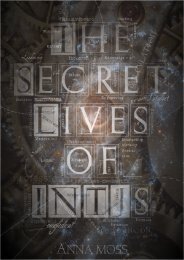You also want an ePaper? Increase the reach of your titles
YUMPU automatically turns print PDFs into web optimized ePapers that Google loves.
The 31 type experts considered the following two descriptors characteristic of Ni: "mystical" and<br />
"Trusts the unconscious." "Mystical" was also considered to be somewhat characteristic of Fi, and<br />
"trusts the unconscious" was also considered to be somewhat characteristic of Ne and Fe. This begs<br />
an obvious question. Why is it that out of 25 suggested descriptors for Ni, only 2 of them were<br />
actually sort-of-agreed-upon by type practitioners?<br />
It is quite simple: no one actually knows what Ni is, and everyone is using their own unique<br />
definition of the term. Therefore there is no one consensual meaning of Ni—rather, there are 31<br />
meanings of Ni, each one unique to a specific type user. Such sloppy non-definitions allow<br />
unlimited interpretations of data, thus making any claims for or against cognitive functions<br />
unproven and unprovable. Ni was, in fact, the most poorly differentiated cognitive function of all.<br />
Another interesting point is that the raters' agreed-upon descriptors for Ti (the INTJ auxiliary) seem<br />
to match INTJs better than the descriptors for Ni (the dominant). Ti is, of course, the supposed<br />
dominant of INTPs/ISTPs.<br />
12 descriptors were found that matched Ti. 46 The list was as follows: aloof, cold, desires internal<br />
logic, detached, in-depth concentration, independent, individualistic, likes mental models,<br />
overcomplexifies, pure intellectual, research-minded, and unique use of logic.<br />
These 12 descriptors fit type INTP, as would be expected since Ti is the INTP's dominant function.<br />
But as far as I can tell, all 12 descriptors match both INTPs and INTJs equally well. However, only<br />
five of the descriptors seem to fit type ISTP (aloof, cold, desires internal logic, independent, and<br />
individualistic).<br />
Ti is not the dominant of INTJs, yet the descriptors of Ti seem to fit both INTJs and INTPs to a tee.<br />
Ti is the dominant of ISTPs, yet the descriptors do not seem to fit type ISTP as well. Yet Ni, not Ti,<br />
is believed to be the dominant of the INTJ.<br />
What can we say about this? Even if one accepts that the cognitive functions exist, the murkiness<br />
and paucity of these descriptors must give one pause. There would seem to be little use in trying to<br />
use the cognitive functions to tell INTJs apart from INTPs.<br />
Here is a list of other characteristics that can be helpful in differentiating INTJs from INTPs.<br />
Judging vs. Perceiving Differences<br />
• INTJs like following a regular schedule. INTPs aren't interested in having a routine.<br />
• INTJs tend to have neat rooms, cars, and desks. INTPs tend to have messy rooms, cars, and<br />
desks.<br />
• INTJs like clear structure more than INTPs. Indeed, INTPs are the least enthralled with<br />
clear structure of all types. 47<br />
• INTJs tend to make a plan and then follow it through. INTPs would rather just figure it out<br />
as they go along. Both types will create far-reaching strategies, however.<br />
• INTJs are more persevering; INTPs are more flexible.<br />
• INTJs are better at preparing in advance; INTPs are better at improvising on the spot.<br />
• INTJs like to come to decisions quickly and seek closure; INTPs tend to leave their options<br />
open as long as possible so that they can gather information.<br />
• INTJs tend to put work before play; INTPs tend to put play before work.<br />
46 However, for 5 of these 12 descriptors, secondary matches with Te, plain N, and Ni were found. In short, the<br />
surveyed experts thought that those five descriptors mainly matched Ti, but also secondarily matched Te, N, and<br />
Ni.<br />
47 Myers, McCaulley, Quenk & Hammer, 1998




